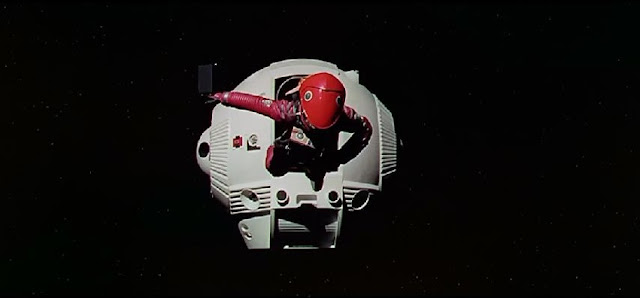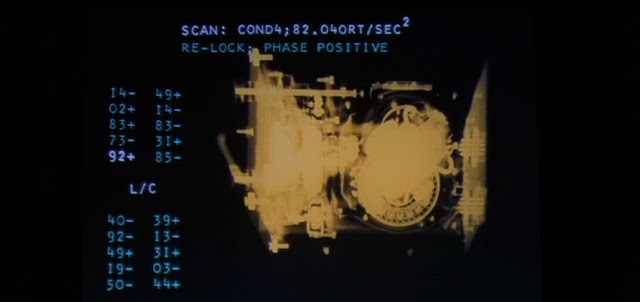In 2001, David Bowman experiences the hero's journey. "Hero's journey" is another name for Joseph Campbell's monomyth, which, according to the Wikipedia 'Monomyth' page,[a] is a basic pattern that its proponents argue is found in many narratives from around the world. This widely distributed pattern was described by Campbell in The Hero with a Thousand Faces (1949). An enthusiast of novelist James Joyce, Campbell borrowed the term monomyth from Joyce's Finnegans Wake.
Campbell held that numerous myths from disparate times and regions share fundamental structures and stages, which he summarized in The Hero with a Thousand Faces:
Campbell and other scholars, such as Erich Neumann, describe narratives of Gautama Buddha, Moses, and Christ in terms of the monomyth and Campbell argues that classic myths from many cultures follow this basic pattern.
In a monomyth, the hero begins in the ordinary world, and receives a call to enter an unknown world of strange powers and events. The hero who accepts the call to enter this strange world must face tasks and trials, either alone or with assistance. In the most intense versions of the narrative, the hero must survive a severe challenge, often with help. If the hero survives, he may achieve a great gift or "boon." The hero must then decide whether to return to the ordinary world with this boon. If the hero does decide to return, he or she often faces challenges on the return journey. If the hero returns successfully, the boon or gift may be used to improve the world. The stories of Osiris, Prometheus, Moses, and Gautama Buddha, for example, follow this structure closely.
Campbell describes 17 stages or steps along this journey. Very few myths contain all 17 stages—some myths contain many of the stages, while others contain only a few; some myths may focus on only one of the stages, while other myths may deal with the stages in a somewhat different order. These 17 stages may be organized in a number of ways, including division into three sections: Departure (sometimes called Separation), Initiation, and Return. "Departure" deals with the hero's adventure prior to the quest; "Initiation" deals with the hero's many adventures along the way; and "Return" deals with the hero's return home with knowledge and powers acquired on the journey.
The stages of the monomyth, and their depiction in A Space Odyssey, are described below. (Note that not all of the 17 stages are being depicted in Kubrick's movie).
Departure
1. The Call to Adventure: The hero starts off in a mundane situation of normality from which some information is received that acts as a call to head off into the unknown. This is represented in 2001 by HAL's announcement to Bowman and Poole that the AE-35 unit is about to fail. Up to this point, there has been normalcy aboard Discovery One, in the sense that a steady routine has been followed during the mission; but now, Bowman must 'venture' into the unknown (space) to retrieve the unit.
Bowman has ventured into space, after HAL has announced something is wrong with the AE-35 unit.
2. Refusal of the Call: Often when the call is given, the future hero first refuses to heed it. This may be from a sense of duty or obligation, fear, insecurity, a sense of inadequacy, or any of a range of reasons that work to hold the person in his or her current circumstances. Bowman does not appear to undergo this stage - there is no refusal on his part to venture out of the ship.
3. Supernatural Aid: Once the hero has committed to the quest, consciously or unconsciously, his or her guide and magical helper appears, or becomes known. More often than not, this supernatural mentor will present the hero with one or more talismans or artifacts that will aid them later in their quest. The 'supernatural' in our case is the alien, and it 'makes itself known', in a sense, via its working with HAL, when Poole is attacked and thrown into space, and also when it makes Bowman forget to put on his space helmet when he goes out to retrieve Poole. Obviously the alien is not lending aid here, but is instead attempting to do away with the astronauts, so it is really acting counter to this stage of the monomyth paradigm, in the sense that Bowman experiences a negative 'version' of this stage: The alien is betraying the hero. Note that the 'talisman or artifact' mentioned above, is here the AE-35 unit itself.

The above left screencap shows Bowman withdrawing the (supposedly) defective AE-35 unit from the Discovery One communications antenna, while a new unit is sitting next to him (as indicated by the black arrow). The above right screencap shows Bowman visually inspecting the unit he has just removed. We are never actually shown him installing the new unit in the antenna, for it is at the point shown here that the camera cuts to the view shown at below left, where we see what appears to be an X-ray image of the (again, supposedly) defective unit, with its cover plate removed, as it is being examined in the Discovery One pod bay. The below right screencap shows a 'HAL's-eye' view of Poole and Bowman examining the unit.

4. The Crossing of the First Threshold: This is the point where the person actually crosses into the field of adventure, leaving the known limits of his or her world and venturing into an unknown and dangerous realm where the rules and limits are not known. This stage is represented in the movie when Bowman re-enters Discovery One through the emergency airlock.
Bowman's crossing of the threshold, and his entry into the belly of the whale as well, is represented by his entering Discovery One through the emergency airlock.
5. Belly of The Whale: The belly of the whale represents the final separation from the hero's known world and self. By entering this stage, the person shows willingness to undergo a metamorphosis. When Bowman enters the ship through the emergency airlock, this represents his entry into the belly of the whale.
------------------------------------------------------------------------------------------------------------------------
Initiation
1. The Road of Trials: The road of trials is a series of tests, tasks, or ordeals that the person must undergo to begin the transformation. Bowman's task, his ordeal, comes when he defeats HAL.
2. The Meeting With the Goddess: This is the point when the person experiences a love that has the power and significance of the all-powerful, all encompassing, unconditional love that a fortunate infant may experience with his or her mother. This is a very important step in the process and is often represented by the person finding the other person that he or she loves most completely. The alien, as Melusina, is the goddess here, and Bowman is to see uniting with her as uniting with his true love.
3. Woman as Temptress: In this step, the hero faces those temptations, often of a physical or pleasurable nature, that may lead him or her to abandon or stray from his or her quest, which does not necessarily have to be represented by a woman. Woman is a metaphor for the physical or material temptations of life, since the hero-knight was often tempted by lust from his spiritual journey. The physical and pleasurable temptations which Bowman faces are those in the 'hotel' room (the Louis XVI-style bedroom) - objects of art, real food, etc. Recall that the hotel room is created by the alien race, from Bowman's unconscious contents.
Bowman in the Louis XVI-style bedroom, surrounded by objects of art, and eating real food.
4. Atonement with the Father: In this step the person must confront and be initiated by whatever holds the ultimate power in his or her life. In many myths and stories this is the father, or a father figure who has life and death power. This is the center point of the journey. All the previous steps have been moving in to this place, all that follow will move out from it. Although this step is most frequently symbolized by an encounter with a male entity, it does not have to be a male; just someone or thing with incredible power. The 'ultimate power' in A Space Odyssey is represented by the monolith, which sits near the foot of Bowman's bed at the point in the movie shown below.
5. Apotheosis: When someone dies a physical death, or dies to the self to live in spirit, he or she moves beyond the pairs of opposites to a state of divine knowledge, love, compassion and bliss. A more mundane way of looking at this step is that it is a period of rest, peace and fulfillment before the hero begins the return. Recall that Bowman, in becoming Mercurius/brahman at the point at which his body is fully infused with the alien life force and is reborn, has united and then dissolved all internal opposites.
6. The Ultimate Boon: The ultimate boon is the achievement of the goal of the quest. It is what the person went on the journey to get. All the previous steps serve to prepare and purify the person for this step, since in many myths the boon is something transcendent like the elixir of life itself, or a plant that supplies immortality, or the holy grail. The alien has provided Bowman with a kind of immortality, and he is now ready for the stages of Campbell's third phase, the Return. The fact that he has returned (to Earth) is symbolized by the giant fetus floating near Earth at the end of the movie.
a. Wikipedia, 'Monomyth'. Web, n.d. URL = https://en.wikipedia.org/wiki/Monomyth.






